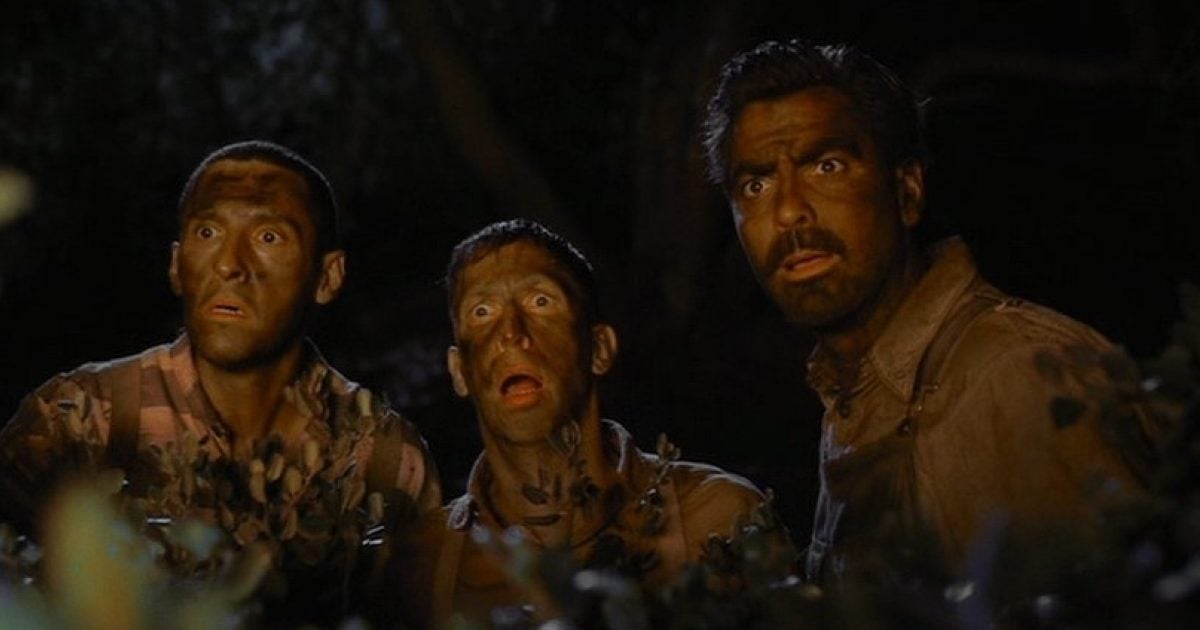O Brother, Where Art Thou? is not the first time an entire motion picture has been digitized and then converted back to film for distribution. Gary Ross did it on Pleasantville (shot by John Findley, ASC; AC Nov. ’98), and Jon Shear color-timed Urbania, a Super 16 film, in a digital suite (Shane Kelly; AC May ’00). George Lucas digitized The Phantom Menace (David Tattersall, BSC; AC Sept. ’99), but his purpose was to integrate visual effects and live action components in literally hundreds of shots.
Although O Brother, Where Art Thou? contains a number of visual effects shots, those scenes were incidental to the decision to digitize the film. In fact, the Coen brothers saw the computer as just another tool for extending the art and craft of cinematography. There is more than a little irony in that decision, however, since neither the Coens nor Deakins think of themselves as digital mavens. In fact, the Coens still edit on a traditional flatbed console because they feel that it gives them more tactile control of the film.
Writer-producer Ethan and writer-director Joel began making movies in 1984 with the acclaimed thriller Blood Simple (which was recently rereleased in theaters in a special “director’s cut”). Their films typically explore the dark side of humanity and feature characters who stick in viewers’ memories long after the last flickering images have disappeared from the screen. O Brother, Where Art Thou? is Deakins’ fifth collaboration with the brothers, following Barton Fink, The Hudsucker Proxy, Fargo and The Big Lebowski. (He is currently shooting the sixth, The Barber Project [The Man Who Wasn’t There].) Other notable credits in Deakins’ body of work include Sid and Nancy, Thunderheart, Stormy Monday, The Secret Garden, 1984 and The Hurricane. He earned a 1994 ASC Award and an Oscar nomination for The Shawshank Redemption, as well as both Academy and ASC Award nominations for Fargo and Kundun.
Also Read: Photographing The Shawshank Redemption
“Before I read the script [for O Brother, Where Art Thou?] Joel and Ethan told me they had a film they wanted to shoot in the South,” Deakins recalls. “They imagined something dry, dusty and very hot.” Texas was initially chosen as the primary location, but the filmmakers eventually switched to Mississippi. “I’ve worked in Louisiana and Alabama [on Passion Fish and The Long Walk Home,] so I knew that the region would be wet and the foliage would be various shades of lush green — and about half the picture would take place in exteriors.”
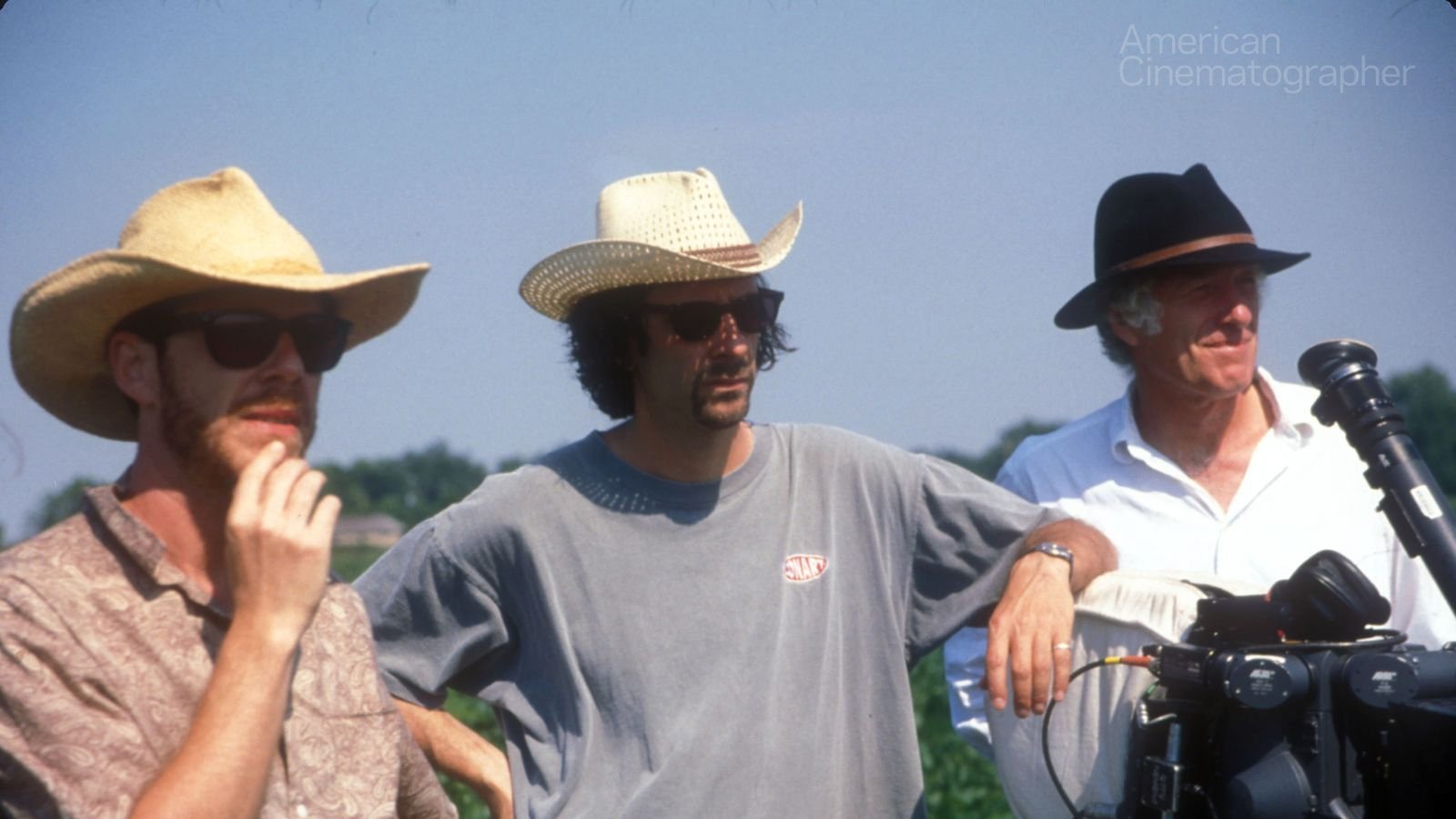
The filmmakers briefly considered changing locations again, but Mississippi’s unique delta landscapes drew them back. “It would have been a different scenario if we had been shooting in the winter or if we’d been able to take in fall colors, but our film was scheduled for a summer shoot,” Deakins recalls. “I had to find a way to desaturate the greens and give the images we were going to shoot the feeling of old, hand-tinted postcards, [which was the look] favored by Joel and Ethan.”
To prepare for the production, the filmmakers shot some footage at Griffith Park in Los Angeles, where the trees were particularly green and therefore similar to those they were about to be surrounded by in Mississippi. This footage was then subjected to a series of tests by Beverly Wood at Deluxe Laboratory. According to Deakins, tests such as bleach-bypass and ACE produced interesting desaturation but could not be applied in a selective way. The most promising option was a bi-pack system combining a black-and-white panchromatic dupe with the original color negative. Deakins notes that although this technique provided a great deal of control over saturation, it was not selective enough. “I remembered that some years ago, when we shot 1984, we’d had a similar problem,” he says. “We originally wanted to shoot in black-and-white, but the project’s backers wouldn’t allow it. Instead, we decided to go for a harsh, desaturated look using a bleach-bypass system at Kays Laboratory in Great Britain, where the staff was performing tests for us. The challenge was to create the very golden, colorful looks for the scenes that required them as a counterpoint to the starkness of the main body of the film. On those few scenes, we wound up using very heavy filtration to counteract the bleach-bypass.”
While doing tests at Deluxe for O Brother, Where Art Thou?, Deakins began to consider the new digital technology at his disposal. He was aware of Lindley’s experience on Pleasantville and knew of Cinesite in Hollywood, which handled all of the film scanning and recording on that project. He thought that if he could scan the entire film into digital format, he would have infinite control over the look in the digital suite, but he wasn’t sure it would be affordable. Deakins discussed the concept with the Coen brothers, who were familiar with the technique, and they asked him to conduct more tests.
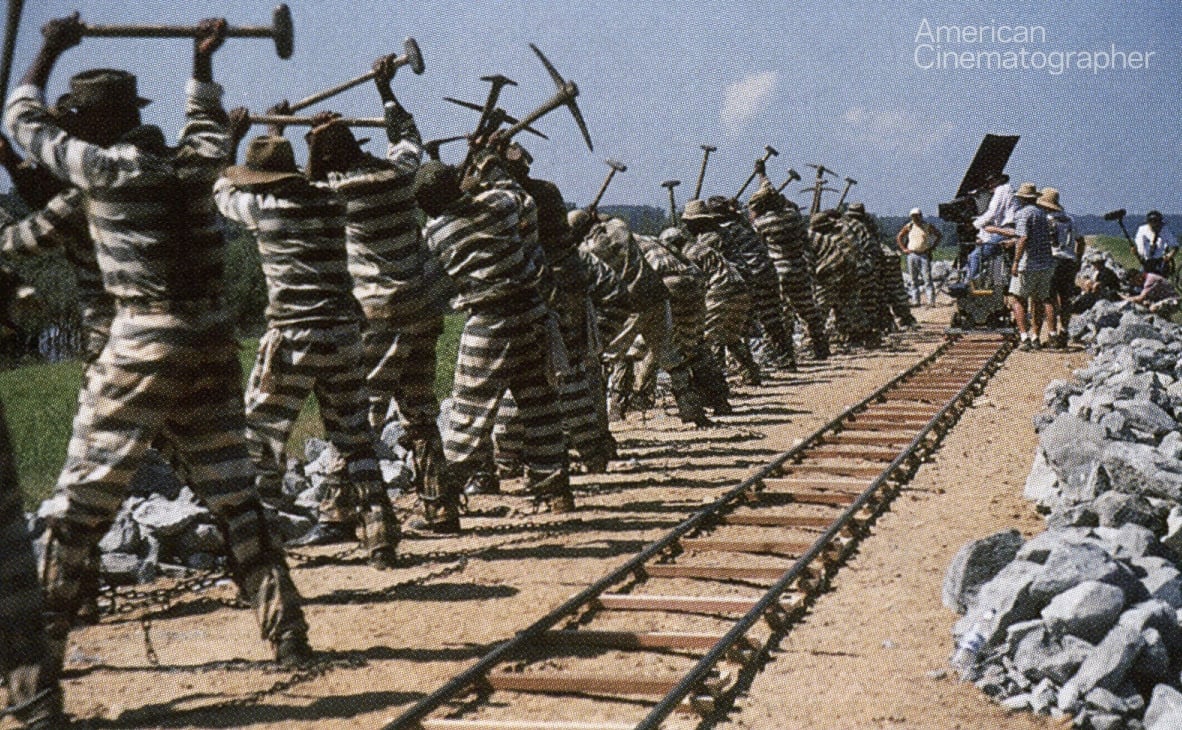
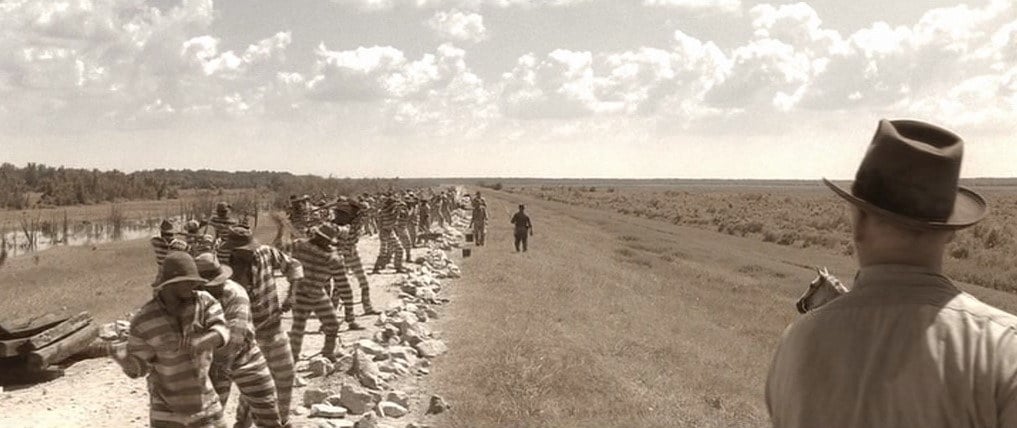
Some of the negative from the Griffith Park tests was scanned into digital format with a Philips Spirit DataCine at 2K resolution using a proprietary look-up table developed for this application. Deakins viewed the digital images with Cinesite colorist Julius Friede. Together, they worked on manipulating the saturation of the images, and in particular selecting the greens of the trees and grass and turning them into dry browns and yellows. At that point, Cinesite recorded the digital file onto the same 35mm Eastman EXR color intermediate film (5244) that labs use for making internegative and interpositive masters for release printing. A Kodak Lightning film recorder with a high-intensity laser light source was used to convert the digital files to analog images on the intermediate film. The film was then processed by Deluxe in Los Angeles, which also made a work print.
The tests convinced Deakins and the Coen brothers. “They like to try new things,” the cinematographer says. “We knew it would be taking a risk, but Cinesite gave us a good price, and quite honestly it was the only way we could see of achieving the look that all three of us wanted.”
O Brother, Where Art Thou? was also the Coen brothers’ first experience shooting in a widescreen format (2.4:1 aspect ratio), which Deakins had suggested because of the importance of the landscapes and the epic nature of the story. He recommended shooting in the Super 35 format, in part because he liked the perspective rendered by the spherical lenses he’d used on Kundun. “Every film defines its own palette of colors and textures,” he says. “I didn’t want glossy images. The spherical lenses have the effect of pulling the audience closer to the characters; it’s more intimate [than anamorphic]. To my mind, the feeling of depth recorded on Super 35 would augment the picture-book quality of the story.”
Deakins worked mainly with a single Arri 535 camera and the new Cooke S4 prime lenses. “I think it’s important to work with the sharpest lenses you can get — especially if you’re going to convert the film to digital format — but that’s what I typically do anyhow. I rarely use filters to soften a look, so it didn’t affect my decisions [regarding] lenses and filtration.” The cinematographer notes that the Cooke lenses record “very clean” images with very little flare. A number of times he shot directly into the sun without any glare. There also were a number of night shots motivated by very bright flames, including burning torches. He says the pictures were sharp and clean with no double images or kickbacks.
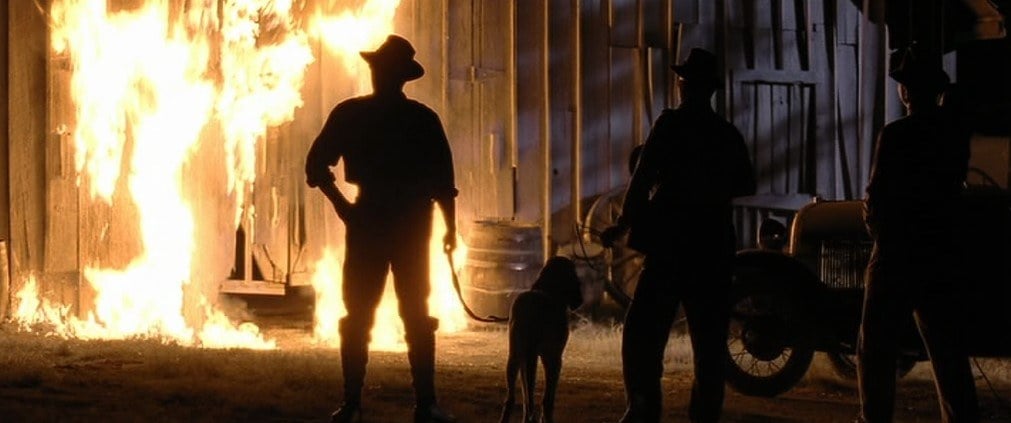
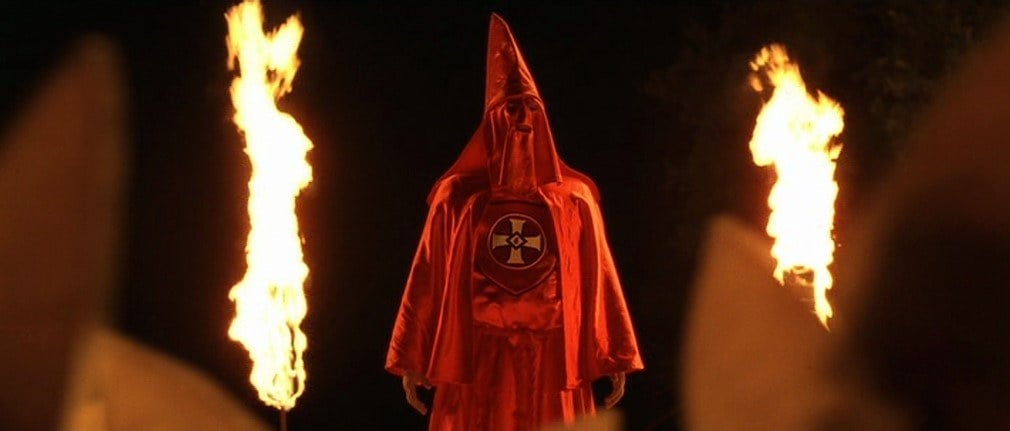
After testing, Deakins settled on three film stocks. He used Kodak Vision 500T 5279 for night interior and exterior scenes, and Eastman’s EXR 5248 100-speed emulsion for most daylight exteriors. While shooting daylight sequences in shadowy forest locations, he sometimes opted for the 200-speed Eastman EXR 5293, which he also used for recording bluescreen elements of composite shots.
The entire film was storyboarded, right down to exact angles of coverage. Deakins says there was considerable discussion about the boards during preproduction. “We stayed pretty close to the plan, veering from it only when something spontaneous presented an unexpected opportunity.”
The locations in and around Jackson, Mississippi, were relatively bare, though there were some shacks and buildings that could have passed for 1930s structures. “We built a couple of sets in a warehouse, because the weather is a bit unpredictable in that part of the country at that time of year,” Deakins says. “But we were only rained out once — lucky, I guess!”
The camerawork in the film is more objective than subjective, revealing the story to viewers as if they are spectators rather than participants. Deakins offers that the result is almost like watching a play, although he notes that the picture also has moments that are like musical interludes verging on fantasy (a tactic previously employed by Deakins and the Coens in The Big Lebowski). “Those moments aren’t structurally necessary for the plot,” he says. “It is almost an operatic or circus experience, like a Fellini film in many ways.”
The camera is almost constantly in motion, though not as much as it was in, say, Barton Fink. “I generally prefer to be on a crane arm with a remote head, but sometimes it proved more practical to use a Steadicam over rough ground,” Deakins says. Much of the film was shot utilizing a Power Pod remote head and an Aerocrane jib arm. “ [That rig] allows a lot of flexibility in terms of camera movement, and it’s often a great time-saver. For one campfire scene, which leads the three main characters into a baptism ceremony, we shot all five setups with the Aerocrane on the same piece of track. We had been rained out all morning, but it brightened up enough in the afternoon to start shooting. We were in very thick forest; I knew it would be getting dark very early, so we had to work quickly.
